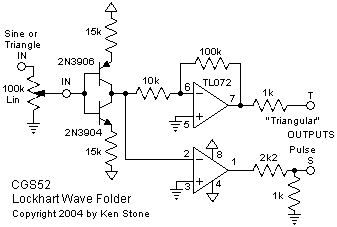|
DISCONTINUED The Simple Wave Folder is an ideal beginners project for two reasons - it is simple to build, and its effect is powerful - far beyond what could be suspected from such a simple circuit. The effect it produces is not like unlike that of the Serge middle wave multiplier - harmonically rich waveforms that can be swept for filter-like effects. It MUST be fed a triangle or sine wave to function properly. Some ideas on how to use this module: Unlike the more complex CGS29 Wave Multipliers this module does not include any dynamic controls. For modulation, either mix in a DC offset using an external mixer, or modulate the level of the incoming signal using a VCA. The module expects an incoming triangle or sine wave centered around zero volts, though a small DC offset can be tolerated for the purpose of effects. If waveforms from the VCOs in the system to which it is connected are not centered around zero volts, a decoupling capacitor should be added. The DC offset can of course be supplied by an LFO. Some interesting effects can be achieved by feeding the pulse output into a CGS01 Sub-oscillator/harmonic sequencer. A little on how it works:

The schematic of the simple wave folder. This circuit is based on "Nonselective Frequency Tripler Uses Transistor Saturation Characteristics" by R. Lockhart, Jr., in Electronics Design, Aug. 16, 1973. Its functionality is not unlike Moog's single transistor sawtooth to triangle wave converter. It's intended purpose is to convert a signal into another of three times the frequency. To do this it expects a +/-1.2 volt triangle or sine wave, and outputs a +/-0.4 volt complex waveform. Unfortunately, due to the uneven spacing of the frequency multiplied waveform, it does not sound like it is a fifth above the incoming signal. This of course is of no particular concern in this application, as the purpose of this module is to create a complex harmonic structure from a simple input, not to triple the frequency. To convert typical synthesizer signal levels to something appropriate for driving this module, and to allow for variation, a 100k pot is used as an adjustable potential divider, or input level control. The output is buffered by an inverting amplifier with a gain of 10 to bring the level back to something useful. The folded waveform is available from this output (T). The output of the transistor stage is also fed to a comparator with its sense input at 0 volts. The output is level corrected to approx. +/- 5 volts. A pulse waveform is available from this output (S). The pulses fall in an uneven but repeating pattern. Modulating the input can change the width of these pulses, or move them back and forward with respect to each other, depending in whether the amplitude of the incoming signal or the D.C. offset is modulated. Construction

The component overlay. Connections can be determined from the circuit diagram. There is space on the copper side of the PCB for two 10n decoupling capacitors. Notes:
Parts list This is a guide only. Parts needed will vary with individual constructor's needs.
|